More than a century before women saw themselves in Carrie, Samantha, Charlotte, and Miranda, they identified with another popular foursome: the March sisters of Little Women. Chances are, if you grew up reading Louisa May Alcott’s coming-of-age novel, you’ve probably asked yourself: Are you romantic like Meg, outspoken and defiant like Jo, gentle and quiet like Beth, or boisterous and a bit vain like Amy?
The relatability of the four sisters is just one of the reasons why Alcott’s text has endured, and why its universe has continued to expand since it was first published in two parts in 1868 and 1869. For the past 150 years, it has been translated into more than 50 languages and adapted for the stage and screen more than a dozen times, including a 48-episode Japanese television series.
AdvertisementADVERTISEMENT
But the latest adaptation to enter the canon, which is written and directed by Greta Gerwig, is less about categorizing the women into four separate archetypes and instead showing how they reflect each other: four parts of one whole. For the hair and makeup departments, that meant making each of the women — Jo (Saoirse Ronan), Meg (Emma Watson), Beth (Eliza Scanlen), and Amy (Florence Pugh) — look more similar than different.
“I wanted each girl to echo the others,” Fríða Aradóttir, the head of the film’s hair department, told me over the phone. “I wanted them to have similar repeat hairdos. The way they put their hair up and braid it — it’s suggested that they took care of each other and helped to do each other’s hair.” Of course, this doesn’t always go according to plan. In an early scene at the March’s home in Concord, Massachusetts, Jo burns a lock of Meg’s hair with a hot iron while trying to curl it for a party.
But elaborate party updos are few and far between in this adaptation. In fact, Gerwig actually encouraged Aradóttir and her team to envision the March sisters as early bohemians and provided photos from Victorian-era British portrait photographer Julia Margaret Cameron as inspiration. “Greta, early on in our conversations, suggested that this family and these girls and women were possibly the original hippies,” explained Aradóttir. “The hair was always meant to be a little less structured than you see in a lot of period movies. I find that more relatable than coiffures, which are so distinct and untouchable.”
AdvertisementADVERTISEMENT
Staying true to the times, Aradóttir didn't even allow hairspray on set, since it hadn't yet been invented in the 1860s when the story takes place. “Let [the hair] be flyaway, let it be loose!” was the directive Aradóttir told me she gave her team. “On Jo, there were always pieces falling down — she was too busy thinking about a lot of other things and not tucking her hair in.”
Although the styles were meant to look effortless, they required tons of prep work. Ronan, Watson, Scanlen, and Pugh each wore three-quarter-length wigs or hairpieces, as none of them had the long, flowing hair that was typical of the period. Each day, Aradóttir and her team — which included three hairdressers on staff and up to 15 stylists on the days they shot the ballroom dancing scenes — would wash the wigs with Moroccanoil shampoo and condition them with Rahua hair masks to give them a healthy-looking sheen. To complete the looks, they used Rodin Olio Lusso luxury oil and Omorovieza moisture mist.
Judy Chin, the makeup department head, also took a pared-down approach to the makeup, keeping with the style of the time when it was still deemed unseemly. “My conversations with [Gerwig] were about having the girls just look wild and natural,” Chin said to me over the phone. “I took all of their features and enhanced them.” Of course, pulling off a no-makeup look on the big screen also takes serious effort.
AdvertisementADVERTISEMENT
Chin and her counterpart, Miho Suzuki, started by pressing Nars Sheer Glow Foundation and Ko Gen Do Moisture Foundation into their skin, then added that signature Victorian flush to their lips and cheeks using rose and coral stains from Tarte, Duwop, and Lancôme. “I wanted them to look very natural and strong and beautiful,” said Chin, “without any sort of noticeable cosmetic enhancement.”
One thing that neither Aradóttir nor Chin used for inspiration, however, was the dozen-plus previous adaptations of the film, including the popular 1994 version starring Winona Ryder as Jo. In fact, both women made a conscious decision not to watch the previous versions at all. “I’ve seen bits of [prior adaptations] and what they look like,” said Chin. “And no offense to any of them, but what I wanted to do was the complete opposite of what I saw. They’re all great in their own ways, but I wanted to create something different and more real.”
Ultimately, this vision for hair and makeup — that the March sisters are meant to mirror one another — supports Gerwig’s vision more broadly. In her film, whether you identify with Meg, Jo, Beth, or Amy is almost irrelevant. Her Little Women is intimately aware of how, even though the sisters march to the beat of their own drum, the family is still oppressed by the same patriarchal society that encourages women to marry — including their mother, Marmee (Laura Dern), who confesses to Jo that she is angry every day of her life; Gerwig’s film is only the second adaptation to include this pivotal line from the book.
AdvertisementADVERTISEMENT
Accordingly, the March sisters make the brunt of their decisions with family in mind. In a scene that’s also famous in the book, a teenage Jo cuts her hair and sells it in exchange for money to give her mother. Her sisters accuse her of abandoning her “one beauty,” but Dern’s Marmee is quietly moved.
Later on, it is Amy who sacrifices her ambitions as a painter in order to marry the wealthy Laurie (Timothée Chalamet) and support her family financially: “As a woman, there’s no way for me to make my own money,” she tells Laurie, steely-eyed, her hair pulled off her face in an elegant updo. “Not enough to earn a living or to support my family, and if I had my own money, which I don’t, that money would belong to my husband the moment we got married... so don’t sit there and tell me that marriage isn’t an economic proposition, because it is."
By the end of Gerwig’s film, Jo has written the novel Little Women, started her own school, and (maybe) married Professor Bhaer; Amy has married Laurie; and Meg has married John Brooke, Laurie’s tutor. However, it is never lost on the viewer that the March women remain parts of a whole, forever interwoven like braids — not because they want to be, but because they need to be to survive.
At Refinery29, we’re here to help you navigate this overwhelming world of stuff. All of our market picks are independently selected and curated by the editorial team. All product details reflect the price and availability at the time of publication. If you buy something we link to on our site, Refinery29 may earn commission.
AdvertisementADVERTISEMENT





